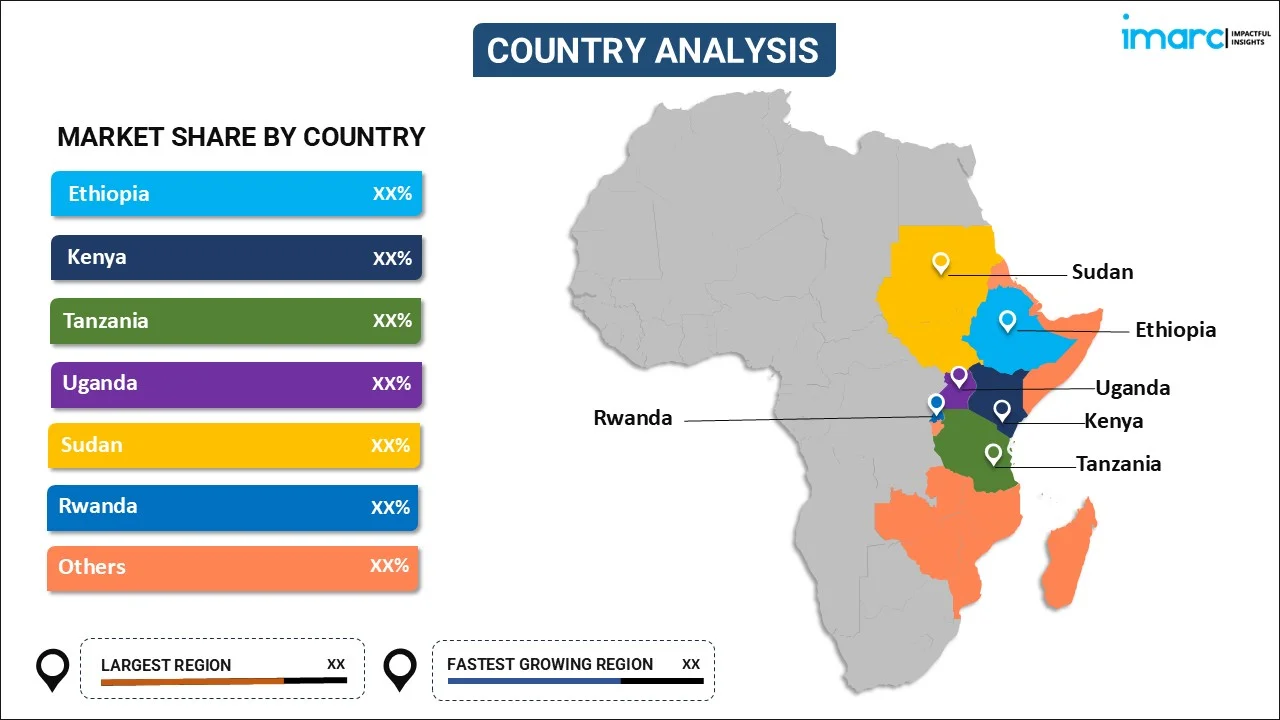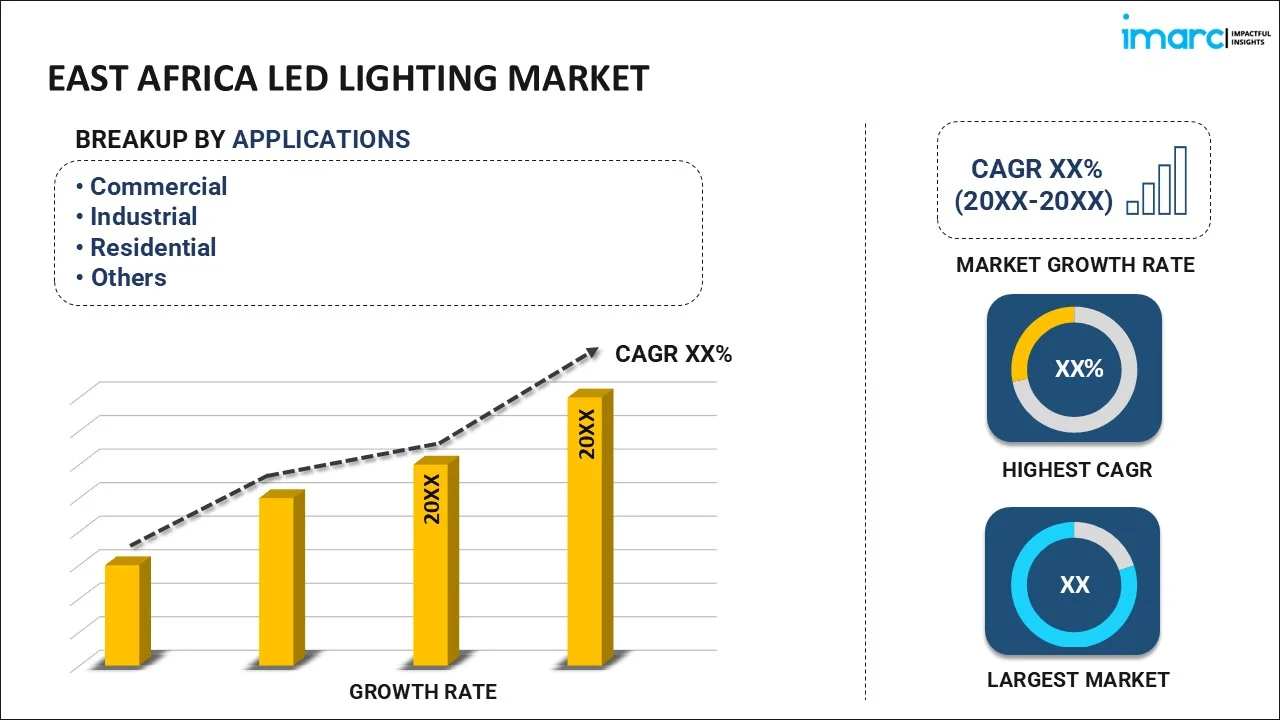
East Africa LED Lighting Market Report by Application (Commercial, Industrial, Residential, and Others), Product Type (LED Bulbs, LED Lanterns and Torches, LED Solar Panels and Fixtures, LED Street Light, and Others), Distribution Channel (Retail Stores, Supermarkets/Hypermarkets, Specialty Stores, and Others), and Country 2025-2033
East Africa Led Lighting Market Size:
The East Africa LED lighting market size reached USD 933.0 Million in 2024. Looking forward, IMARC Group expects the market to reach USD 3,107.0 Million by 2033, exhibiting a growth rate (CAGR) of 14.3% during 2025-2033.
|
Report Attribute
|
Key Statistics
|
|---|---|
|
Base Year
|
2024
|
|
Forecast Years
|
2025-2033
|
|
Historical Years
|
2019-2024
|
|
Market Size in 2024
|
USD 933.0 Million |
|
Market Forecast in 2033
|
USD 3,107.0 Million |
| Market Growth Rate 2025-2033 | 14.3% |
East Africa Led Lighting Market Analysis:
- Market Growth and Size: The market is on a robust growth trajectory, reflecting a positive outlook for the region's energy-efficient lighting solutions. This industry's expansion is fueled by escalating demand for cost-effective and sustainable lighting options, influencing a significant shift in consumer and commercial preferences toward LED technology.
- Major Market Drivers: Increasing energy costs and a strong inclination for energy conservation are major drivers propelling the adoption of LED lighting in East Africa, enhancing the industry's growth prospects. Government initiatives promoting energy efficiency and environmental sustainability are also pivotal in driving the widespread adoption of LED solutions in the region.
- Key Market Trends: The industry is witnessing a key trend towards the integration of smart and connected lighting solutions, reflecting a growing market demand for advanced, energy-efficient technologies. Additionally, the escalating shift towards solar-powered LED lighting, capitalizing on the region's abundant solar energy resources and addressing electricity scarcity issues is creating a positive market outlook.
- Geographical Trends: Countries such as Kenya, Ethiopia, and Tanzania are leading the market in East Africa, showcasing strong growth in the LED lighting industry due to rapid urbanization and infrastructure development. The industry's outlook in these areas is particularly promising, given their expanding economies and increasing investments in public and residential lighting projects.
- Competitive Landscape: The market is characterized by intense competition, with numerous local and international players striving to capitalize on the growing demand for energy-efficient lighting. Companies are increasingly focusing on product innovation, cost competitiveness, and strategic partnerships to establish a strong foothold in the industry.
- Challenges and Opportunities: The market faces challenges such as high initial investment costs and a lack of consumer awareness regarding the long-term benefits of LED lighting. However, the industry presents substantial opportunities for growth, particularly in expanding access to off-grid LED lighting solutions and leveraging technological advancements to enhance product offerings and market penetration.
The market is currently being driven by several factors such as strong government support, declining prices of LED products, infrastructure growth, rising consumer awareness, etc. IMARC Group’s latest report provides a detailed insight into the East Africa LED lighting market covering a comprehensive analysis on Kenya, Tanzania, Uganda, Ethiopia and other East African markets. The report finds that Kenya is currently the largest market for LED products in the region. A key reason behind this is that Kenya has the highest electricity access rate in East Africa with total access being an estimated 75% from both grid and off-grid solutions. The report has also analysed the market in terms of application and has found that out of commercial, industrial, residential and other application sectors, the commercial sector accounts for the largest share. Based on the product type, the report found that street lights accounted for the largest market share. Other major products types were LED bulbs and LED panels. The report has also analysed the key distribution channels for LED products in East Africa and has found that LED products are mainly distributed through retail stores in the region.
Key Market Segmentation:
IMARC Group provides an analysis of the key trends in each segment of the East Africa LED lighting market report, along with forecasts at the regional and country levels from 2025-2033. Our report has categorized the market based on application, product type and distribution channel.
Breakup by Country:

- Ethiopia
- Kenya
- Tanzania
- Uganda
- Sudan
- Rwanda
- Others
Breakup by Application:

- Commercial
- Industrial
- Residential
- Others
Breakup by Product Type:
- LED Bulbs
- LED Lanterns and Torches
- LED Solar Panels and Fixtures
- LED Street Light
- Others
Breakup by Distribution Channel:
- Retail Stores
- Supermarkets/Hypermarkets
- Specialty Stores
- Others
Competitive Landscape:
The report has also analysed the competitive landscape of the East Africa LED lighting market along with the profiles of the key players operating in the market.
Report Coverage:
| Report Features | Details |
|---|---|
| Base Year of the Analysis | 2024 |
| Historical Period | 2019-2024 |
| Forecast Period | 2025-2033 |
| Units | Million USD |
| Segment Coverage | Application, Product Type, Distribution Channel, Country |
| Countries Covered | Ethiopia, Kenya, Tanzania, Uganda, Sudan, Rwanda, Others |
| Customization Scope | 10% Free Customization |
| Post-Sale Analyst Support | 10-12 Weeks |
| Delivery Format | PDF and Excel through Email (We can also provide the editable version of the report in PPT/Word format on special request) |
Key Questions Answered in This Report
The East Africa LED lighting market was valued at USD 933.0 Million in 2024.
We expect the East Africa LED lighting market to exhibit a CAGR of 14.3% during 2025-2033.
The rising infrastructural development across the residential, industrial, and commercial sectors, along with the growing demand for energy-efficient lighting sources, is currently driving the East Africa LED lighting market.
The sudden outbreak of the COVID-19 pandemic had led to the implementation of stringent lockdown regulations across the East Africa region resulting in temporary closure of numerous manufacturing units of LED lighting.
Based on the application, the East Africa LED lighting market can be segmented into commercial, industrial, residential, and others. Among these, the residential sector currently holds the majority of the total market share.
Based on the product type, the East Africa LED lighting market has been divided into LED bulbs, LED lanterns and torches, LED solar panels and fixtures, LED street light, and others. Currently, LED bulbs exhibits a clear dominance in the market.
Based on the distribution channel, the East Africa LED lighting market can be categorized into retail stores, supermarkets/hypermarkets, specialty stores, and others.
On a regional level, the market has been classified into Ethiopia, Kenya, Tanzania, Uganda, Sudan, Rwanda, Others.
Need more help?
- Speak to our experienced analysts for insights on the current market scenarios.
- Include additional segments and countries to customize the report as per your requirement.
- Gain an unparalleled competitive advantage in your domain by understanding how to utilize the report and positively impacting your operations and revenue.
- For further assistance, please connect with our analysts.
 Inquire Before Buying
Inquire Before Buying
 Speak to an Analyst
Speak to an Analyst
 Request Brochure
Request Brochure
 Request Customization
Request Customization




.webp)




.webp)












